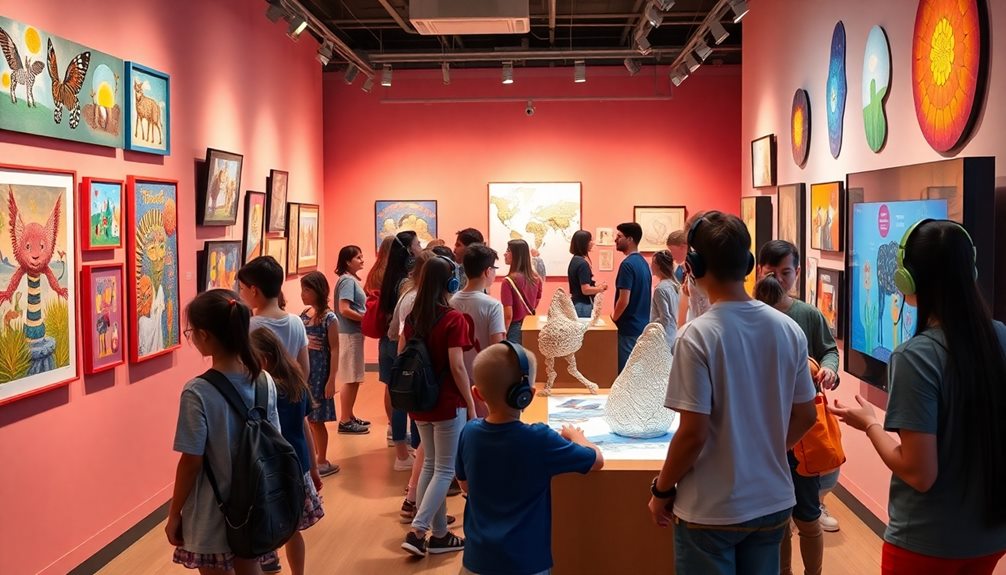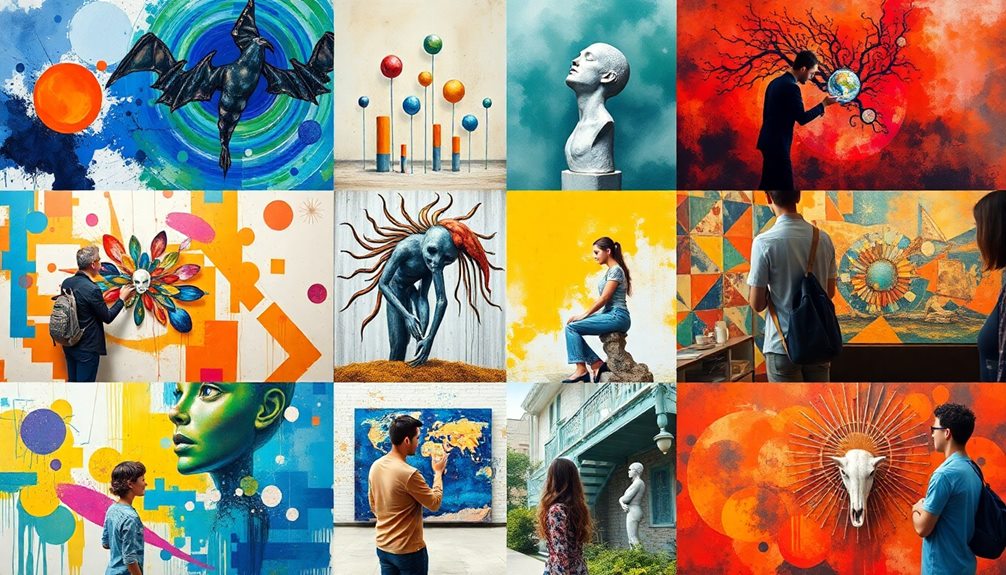In art, common symbols like doves represent peace and the Holy Spirit, while lambs symbolize innocence and Christ’s sacrifice. Flowers like lilies stand for purity and resurrection, and animals such as lions or snakes carry specific meanings tied to stories or virtues. Understanding these symbols helps you grasp the deeper spiritual or cultural messages artists want to convey. If you keep exploring, you’ll discover even more about how these symbols reveal hidden layers of meaning.
Key Takeaways
- Symbols like the lamb represent innocence and Christ’s sacrifice in Christian art.
- The dove signifies peace and the Holy Spirit across various religious artworks.
- The blue robe of Virgin Mary symbolizes purity and divine grace.
- Objects such as keys or crowns denote authority, spiritual power, or victory.
- Natural elements like lilies symbolize purity and resurrection, conveying deeper spiritual meanings.

Have you ever wondered what hidden messages artists embed in their work? When you look closely at art, especially religious pieces, you start to notice a language of symbols that convey deeper meanings. One of the most fascinating aspects is iconography in religious art. This involves the use of specific images, objects, or gestures that carry spiritual significance. For example, saints are often depicted with particular attributes—St. Peter with keys, symbolizing spiritual authority, or the Virgin Mary with a blue robe, representing purity. These symbols serve as visual shorthand, allowing viewers to instantly recognize and interpret complex religious truths. Recognizing iconography helps you understand the story or message behind the artwork, turning it into a visual catechism that communicates faith, morality, and divine truth without words. Additionally, understanding the cultural context of the artwork can further enhance your interpretation and appreciation of the symbols used. Alongside iconography, artists frequently incorporate the use of nature symbols to enhance their message. Nature has long served as a powerful language, with elements like animals, plants, and celestial bodies carrying symbolic weight. You might see a lamb in Christian art, representing innocence and Christ’s sacrifice, or a dove, symbolizing peace and the Holy Spirit. Trees and flowers also carry layered meanings—an olive branch signifies reconciliation, while a blooming lily often symbolizes purity and resurrection. Sun, moon, and stars aren’t just celestial features; they stand for divine guidance, eternity, or enlightenment. When you notice these nature symbols, you’re invited to look beyond their literal appearance and understand their spiritual or philosophical significance. Artists use these symbols intentionally to connect the viewer to universal themes—hope, rebirth, divine presence—making their work resonate on a deeper level. Additionally, understanding the best anime movies that often incorporate symbolic storytelling can expand your appreciation of visual language across different media. Recognizing the symbolic language in art allows for a richer interpretation and a deeper emotional connection with the piece. Exploring art history can further reveal how symbolism has evolved and been used across different periods and cultures. Moreover, the use of natural elements in art emphasizes humanity’s enduring connection with the environment and the cosmos. These symbols act as a secret language, allowing artists to communicate complex ideas that transcend cultural and linguistic boundaries. When you learn to read iconography in religious art and recognize nature symbols, you discover a richer appreciation of the piece. It’s like discovering a hidden code that reveals the artist’s intentions and the spiritual or moral messages they wanted to share. Recognizing these symbols also deepens your connection to the artwork, transforming it from mere decoration into a meaningful dialogue. So next time you encounter a religious painting filled with symbolic imagery or a landscape with meaningful natural elements, take a moment to decode what’s being communicated. You might find yourself more engaged and enlightened, seeing art not just as a visual experience but as a language of profound spiritual insight.
Frequently Asked Questions
How Do Cultural Differences Influence Symbol Interpretation in Art?
When you explore how cultural differences influence symbol interpretation, you realize that cultural perception shapes the meaning you assign to symbols. What’s significant in one culture might be misunderstood or hold different connotations in another. This interpretive diversity highlights that symbols are not universal; they’re shaped by your cultural background, experiences, and beliefs. By understanding this, you can better appreciate the varied ways people from different cultures interpret art.
Can Symbols in Art Have Multiple Meanings Across Different Periods?
You might wonder if symbols in art can have multiple meanings across different periods. Yes, symbol evolution shows that meanings change over time, influenced by cultural shifts and artistic trends. Context dependency plays a vital role, as the same symbol could signify something different depending on the era or society. This fluidity highlights how art communicates diverse messages, making interpretation a dynamic process that evolves with history and context.
How Do Artists Choose Symbols to Convey Specific Messages?
They say “a picture is worth a thousand words,” and you rely on your artistic intuition to choose symbols that resonate deeply. You select personal symbolism that aligns with your message, considering cultural context and emotional impact. By consciously integrating meaningful symbols, you guarantee your artwork communicates your ideas clearly, allowing viewers to interpret your message through a lens of shared understanding and emotional connection.
Are There Universal Symbols Recognized Worldwide in Art?
You might wonder if there are universal symbols recognized worldwide in art. While some symbols, like the cross or heart, have strong cultural symbolism, true symbol recognition varies across cultures. You should remember that cultural symbolism influences how symbols are understood, so many icons aren’t universally interpreted the same way. This diversity highlights the importance of context in appreciating art‘s messages, making symbols both powerful and nuanced in their meaning.
How Has Digital Art Changed the Use of Traditional Symbols?
You see, digital art has transformed traditional symbols through digital iconography and virtual symbolism. You now use pixels and screens to convey meanings, often blending old symbols with new tech. This shift allows you to experiment more freely, creating multi-layered messages that adapt to online cultures. As a result, symbols become dynamic, evolving with digital trends, and you can communicate complex ideas instantly across global audiences.
Conclusion
You might think symbols are just decorative, but they actually carry powerful meaning in art. Recognizing these symbols helps you connect deeper with the artist’s message and the story behind the piece. Even if you’re new to art symbolism, don’t worry—you’ll start noticing these signs everywhere. With a little curiosity, you’ll find that symbols reveal hidden layers of meaning, making your art experience richer and more personal. So, keep exploring and let symbols guide you.









